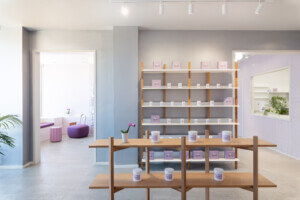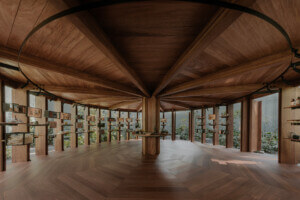Created by up-and-coming architects and designers, the distinct aesthetics of Aesop’s stores have become integral to the Australian skincare brand’s identity. Working with local craftspeople, Aesop integrates each location to its surroundings—no easy feat. The Architect’s Newspaper (AN) editor Matthew Messner spoke with Marsha Meredith, creative director of Melbourne-based Aesop, who explained the ideas and process behind picking new store locations and designers, and discussed the company’s commitment to working with the community.
The Architect’s Newspaper: Could you discuss the process of finding and choosing designers for each store? What do you look for?
Marsha Meredith: We select architects not only for the excellence of their work but also their personality; their capacity to communicate and connect with us is integral to the realization of new spaces. We enjoy working with established architects and rising talents. We first worked with Frida Escobedo in 2013 for a temporary space we opened in Brooklyn, nestled in the Invisible Dog, a local art center. We had come across Frida’s work and reached out precisely because her experience lay in a more conceptual space, away from traditional retail architecture. The design she presented for Invisible Dog connected with the artistic soul of the space while preserving its humble character.
The locations of new Aesop stores also seem to be an important decision. What are some of the factors in choosing a location?
There’s no formula. Intuition plays a big role in choosing the right location, and so do serendipitous recommendations from partners—be it from architects, retailers, or restaurants. In Miami, for example, the Design District might have been a natural choice for a premium retail company, but we felt more at ease in Wynwood. It might have been the murals, the coffee at Panther, or O, Miami, the poetry festival organized by the University of Wynwood collective. We drew inspiration from the local streetscape—its buildings, its history, its people.
How do new Aesop stores tap into local crafts, trades, materials, and history?
As a company, our first consideration is always to work with what is already in place and tread lightly with respect to the past. We then allow the architects to create their original concept. Frida’s inspiration is particularly rich and fertile. In Tampa, her design engaged with the neoclassical style of the restaurant and lifestyle store Oxford Exchange, but adding a terra-cotta sink crafted by Florida-based ceramic artist John Byrd was a subtle yet distinct nod to the area’s Cuban and Spanish influences.
In Coconut Grove, Frida understood the store was located in a bustling shopping space. Her concept was an interesting response to this particular setting: Drawing on the hammock as a tropical motif for repose, the relaxed design diffused an alluring calmness, letting our store become a refuge where one can rest and decompress.
What do you believe is the value added by enlisting critical designers for each store, as opposed to reproducing similar stores in each location?
Enlisting designers who are able to capture a neighborhood is the least we can do. As a retailer with a global presence, we have a responsibility to add value to the neighborhoods in which we open. We seek to weave ourselves into the fabric of the street rather than creating a discordant presence. Collaborations also nurture our own
creative soul: We enjoy the original interpretations of Aesop that come through in each unique design.










